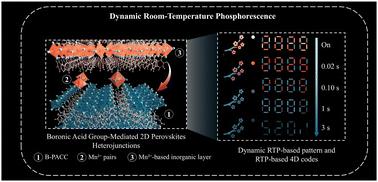硼酸基团介导的二维钙钛矿异质结实现动态室温磷光,用于时间分辨多维防伪和加密
IF 6.4
1区 化学
Q1 CHEMISTRY, INORGANIC & NUCLEAR
引用次数: 0
摘要
动态室温磷光(RTP)材料具有颜色可调的余辉特性,在先进的防伪和多维加密应用中具有很大的前景。在本研究中,我们成功地通过硼酸基辅助结晶法合成了一种新型的二维苯胺氯化镉钙钛矿(B-PACC)。此外,采用精确掺杂策略引入Mn2+,将其组装成Mn2+对,形成Mn2+基无机层。该层与B-PACC一起构建了具有不同层间距的异质结结构,实现了从红色到蓝色的动态余辉发射颜色调制。此外,调整Mn2+浓度可以精确调制从有机部分的单线态和三重态到Mn2+层的能量转移速率,从而可以精细控制动态RTP行为。得益于最小的背景干扰和与红到蓝磷光转换相关的大色度对比度,该系统表现出高的视觉可检测性。基于这种动态余辉行为,我们成功地开发了时间分辨的防伪图案,并构建了基于室温磷光的动态四维(4D)代码,为动态RTP材料的设计和高度安全的加密策略提供了新的见解。本文章由计算机程序翻译,如有差异,请以英文原文为准。

Dynamic room-temperature phosphorescence enabled by boronic acid group-mediated 2D perovskite heterojunctions for time-resolved multidimensional anti-counterfeiting and encryption
Dynamic room-temperature phosphorescence (RTP) materials with color-tunable afterglow characteristics hold great promise for advanced anti-counterfeiting and multidimensional encryption applications. In this work, we successfully synthesized a novel two-dimensional phenylammonium cadmium chloride perovskite (B-PACC) with enhanced RTP efficiency via boronic acid group-assisted crystallization. Furthermore, a precise doping strategy was employed to introduce Mn2+, which assembled into Mn2+ pairs forming a Mn2+-based inorganic layer. This layer, together with B-PACC, constructed a heterojunction structure with different interlayer spacings, enabling dynamic afterglow emission color modulation from red to blue. Moreover, tuning the Mn2+ concentration enables precise modulation of the energy transfer rates from the singlet and triplet states of the organic moieties to the Mn2+ layer, thereby allowing fine control over the dynamic RTP behavior. Benefiting from the minimal background interference and large chromaticity contrast associated with the red-to-blue phosphorescence transition, the system exhibited high visual detectability. Based on this dynamic afterglow behavior, we successfully developed time-resolved anti-counterfeiting patterns and constructed dynamic room-temperature phosphorescence-based four-dimensional (4D) codes, providing new insights into the design of dynamic RTP materials and highly secure encryption strategies.
求助全文
通过发布文献求助,成功后即可免费获取论文全文。
去求助
来源期刊

Inorganic Chemistry Frontiers
CHEMISTRY, INORGANIC & NUCLEAR-
CiteScore
10.40
自引率
7.10%
发文量
587
审稿时长
1.2 months
期刊介绍:
The international, high quality journal for interdisciplinary research between inorganic chemistry and related subjects
 求助内容:
求助内容: 应助结果提醒方式:
应助结果提醒方式:


